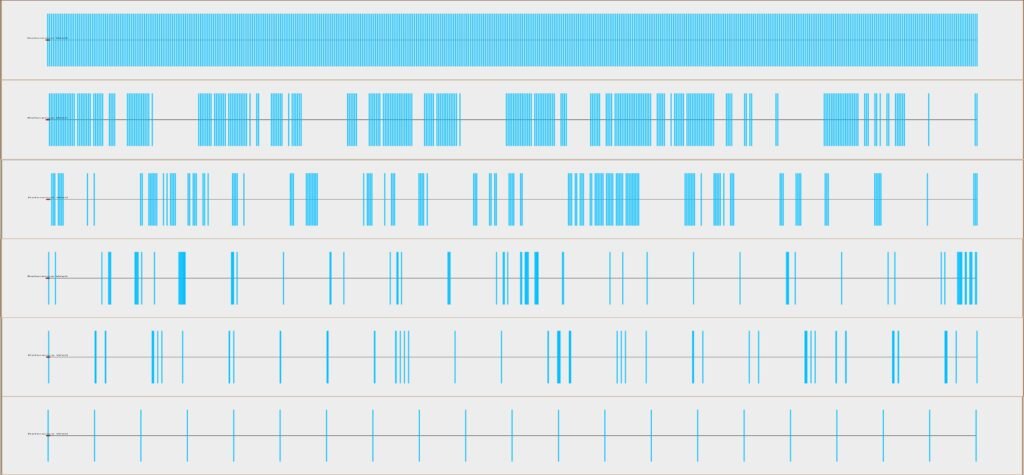Using fractals in Rate Transient Analysis (RTA) of unconventional wells

Due to the very long duration of pressure transient effects, RTA is the only well characterization method available for unconventional wells. But the method used by most practitioners (Classic RTA) assumes equally spaced fractures. Recent research showed unexpected levels of complexity in fracture geometry. The response of wells like these is very different from those with equally spaced fractures as can be easily tested with numerical simulation.
The new Fractional Dimension RTA (FD-RTA) (Acuna, 2017, 2020) is based on fractal theory and provides solution for wells with equally spaced, unequally spaced and random fracture networks. FD-RTA provides much more precise values for fracture area and reservoir volume and the results are the same to Classic RTA when fractures are equally spaced.
Engineers do not have to know the actual fracture geometry, FD-RTA provides that information in the form of two parameters (Xmf and δ) that can be used to create analytical or numerical models for the case of multiphase flow. Well position with respect to neighboring wells is used to determine boundary conditions before long-term predictions can be made.
Why fractals?
A fractal is an object that looks similar whether we look at the entire object or a part of it. Below we see examples of fractal networks of fractures created mathematically (Acuna, 1993). By changing the proportion of smaller to larger pieces we can change the networks between two extremes: a network with a single fracture (D = 1) and a network made up of only the smaller fragments forming a homogeneous medium (D = 2). Thus, fractal networks have non-integer dimension or fractional dimension that fills the gap between these extreme cases (1 < D < 2). The networks shown have dimension of 2, 1.78, 1.65, 1.47 and 1 from left to right.
The hydraulic behavior for a well in the center depends on the fractal dimension so it can be manipulated by changing the fractal dimension.

Fracture swarm models
Fracture swarm models have a fractal fracture spacing distribution along the well direction. They are a convenient way to represent unconventional wells. The fracture spacing distribution is used as the main matching parameter. Examples of these models are shown below for values of δ to 0, 0.1, 0.2, 0.3, 0.4 and 0.5 from top to bottom. Flow behavior of these models exhibit many of the typical features of unconventional wells including higher initial production for low values δ, high decline for low values δ, rapidly increasing GOR for low values δ, etc.

Butterfly models
Although fracture swarm models are very useful as a representation of unconventional wells, multiphase simulation runs take a long time. But, assuming large fracture conductivity, which is very easy to achieve in unconventional wells, it is possible to reorganize the network fragments along a single fracture with the largest spacings at the centers to form a butterfly model (Acuna, 2018b).
The butterfly model has the advantage that it can be set up as a one-dimensional model and runs extremely fast. Multiphase runs take only seconds to complete. The results are equivalent to those of the fracture swarm models even in multiphase. This approach offers a great alternative to conventional numerical simulation and has been successfully used in many wells that a require numerical approach such as condensate wells.
A groundbreaking new tool.
The technology used to develop FD-RTA is innovative and powerful. It not only offers a new way to analyze and match already available production data but adds new insights into the behavior of unconventional wells.
Understanding fracture swarm and butterfly models.
Consulting Services
Unconventional wells production analysis and flow characterization including RTA and Pressure Transient Analysis (PTA).
Geothermal reservoir engineering and modeling including new technologies such as enhanced geothermal and closed loop systems.
Jorge started to work as a field geothermal reservoir engineer in Costa Rica in 1984. In 1988 he went to USC for his doctoral studies focusing his research on pressure transient behavior of fractal networks of fractures that he had to construct numerically for fluid flow simulation. He joined Unocal in 1996 to work in the geothermal division giving technical support to international operations. He did extensive geothermal reservoir simulation and evaluation for many fields in the world. He continued with Chevron Geothermal and Power from 2005 to 2012 and he became Chevron’s leading expert in geothermal reservoir simulation as well as the main developer of methods and tools for geothermal reservoir engineering. At the time Chevron was the largest geothermal company in the world. Geothermal reservoirs are naturally fractured with very low matrix permeability, so he saw the overlap with unconventional wells. He moved into unconventional well characterization and pressure and rate transient analysis with Chevron Technology Company in 2012. Starting in 2016 she leveraged his experience with complex fracture network behavior and fractals to create the new Fractional Dimension Rate Transient Analysis method. Over the next few years, the method was developed, published and implemented in commercial software. He retired from Chevron in 2022 to start his own consulting firm J. Acuna Consulting. He currently lives in Houston.
Acuna J.A. and Yortsos YC. Numerical Construction and Flow Simulation in Networks of Fractures Using Fractals. SPE paper 22703. SPE, 1991.
Acuna J.A., Ershaghi I and Yortsos Y.C. Fractal Analysis of Pressure Transients in the Geysers Geothermal Field. Proceedings 17th Workshop on Geothermal Reservoir Engineering, Stanford University, California, 1992
Acuna J.A. Numerical Construction and Fluid Flow Simulation in Networks of Fractures Using Fractal Geometry. PhD Dissertation. University of Southern California. 1993.
Acuna J.A., Ershaghi I and Yortsos Y.C. Practical Application of Fractal Pressure-Transient Analysis in Naturally Fractured Reservoirs. SPE paper 24705. SPE Formation Evaluation. 1995.
Acuna J.A. and Yortsos YC. Application of Fractal Geometry to the Study of Networks of Fractures and Their Pressure Transient. Water Resources Research, 31(3), pp 527-540, 1995
Acuna J.A. 2016. Analytical Pressure and Rate Transient Models for Analysis of Complex Fracture Networks in Tight Reservoirs. URTeC paper 2429710.
Acuna, J.A. 2017. Pressure and Rate Transient Analysis in Fracture Networks in Tight Reservoirs Using Characteristic Flow Volume. URTeC paper 2667753.
Acuna, J.A. 2018. Alternative Production Mechanisms in Unconventional Reservoirs. URTeC paper 2896802.
Acuna, J.A. 2018. Straightforward Representative Fluid Flow Models for Complex Fracture Networks in Unconventional Reservoirs. URTeC paper 2876208.
Acuna, J.A. 2020. Rate Transient Analysis of Fracture Swarm Fractal Networks. Paper URTeC 2118.
Acuna, J.A. 2021. A Physically Consistent Decline Analysis Method for Unconventional Wells. Paper URTeC 5096.
Lerza, A. and Acuna, J.A. 2022. Well Completion Performance Analysis in the Vaca Muerta Formation by Leveraging Fractional Dimension RTA Method - Case of Study. Paper URTeC 3726020.
Zanganeh, B. and Acuna, J.A. 2022. Fractional Dimension RTA in Unconventional Wells: Application in Multi-Phase Analysis, History Matching, Forecasting and Interference Evaluation. Paper URTeC 3724391.
Acuna J.A. Measurement of Injectivity Indexes in Geothermal Wells with Two Permeable Zones. Proceedings 19th Workshop on Geothermal Reservoir Engineering, Stanford University, California, 1994.
Parini. M.A., Acuna J.A. and Laudiano M. Reinjected Water Return at Miravalles Geothermal Reservoir, Costa Rica: Numerical Modeling and Observations. Proceedings 21st Workshop on Geothermal Reservoir Engineering, Stanford University, California, 1996.
Protacio J.A.P., Golla G.U., Nordquist G.A., Acuna J.A. and San Andres R.B. Gravity and Elevation Changes at the Bulalo Geothermal Field, Philippines: Independent Checks and Constraints on Numerical Simulation. Proceedings New Zealand Geothermal Workshop, 2000.
Acuna J.A., Parini M.A. and Urmeneta N.A. Using a Large reservoir Model in the Probabilistic Assessment of Field management Strategies. Proceedings 27th Workshop on Geothermal Reservoir Engineering, Stanford University, California, 2002.
Acuna J.A., Integrating Wellbore Modeling and Production History to Understand Well Behavior. Proceedings 28th Workshop on Geothermal Reservoir Engineering, Stanford University, California, 2003.
Abrigo M.F, Molling P. and Acuna J.A. Determination of recharge and Cooling Rates Using Geochemical Constraints at the Mak-Ban (Bulalo) Geothermal reservoir, Philippines. Geothermics Vol 33, pp 11-36, 2004.
Nordquist G., Protacio J.A. and Acuna J.A. Precision Gravity Monitoring of the Bulalo Geothermal Field, Philippines: Independent Checks and Constraints on Numerical Simulation. Geothermics Vol 33, pp. 37-56, 2004.
Acuna J.A. and Arcedera B.A., Two-Phase Flow Behavior and Spinner Data Analysis in Geothermal Wells. Proceedings World Geothermal Congress, Antalya, Turkey 2005.
Acuna J.A. A New Understanding of Deliverability of Dry Steam Wells. Geothermal Resources Council Transactions. Vol 32, pp 431-434. 2008. (GRC Best Paper Award)
Acuna J.A., Stimac J., Sirad-Azwar L. and Pasikki R.G. Reservoir Management at Awibengkok Geothermal Field, West Java, Indonesia. Geothermics Vol 37 pp 332–346. 2008.
Acuna J.A. and Pasaribu F. Improved Method for Decline Analysis of Dry Steam Wells. Proceedings World Geothermal Congress, Bali, Indonesia, 2010.
Acuna J.A. Analysis of Pressure Transient Response for an Injector under Hydraulic Stimulation at the Salak Geothermal Field, Indonesia. Proceedings World Geothermal Congress, Bali, Indonesia, 2010.
Peter P. and Acuna J.A. Implementing Mechanistic Pressure Drop Correlations in Geothermal Wellbore Simulators. Proceedings World Geothermal Congress, Bali, Indonesia, 2010.
Nordquist G.A., Acuna J.A. and Stimac J.A. Precision Gravity Modeling and Interpretation – Awibengkok Field, Java Indonesia. Proceedings World Geothermal Congress, Bali, Indonesia, 2010.
